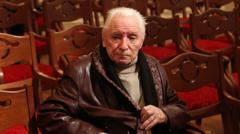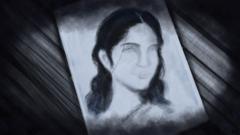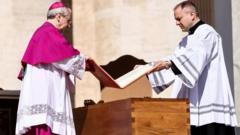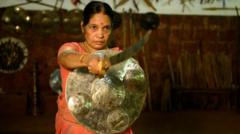The ancient folk performance of Theyyam transforms its performers into deities, encapsulating a rich cultural heritage.
**The Mystical Art of Theyyam: Where Humans Transcend into Divine Beings**
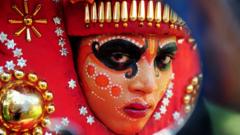
**The Mystical Art of Theyyam: Where Humans Transcend into Divine Beings**
Explore the sacred ritual of Theyyam, a vibrant blend of theatre and devotion in Kerala.
In the southern Indian state of Kerala, the ritual of Theyyam stands as a testament to the convergence of art, spirituality, and tradition. For nearly three centuries, the ancestral home of one esteemed family has served as the stage for this mesmerizing folk ritual, which captures elements of tribal heritage and Hindu mythology while engaging in a deeply spiritual experience. The Theyyam performances, predominantly by male artists from marginalized communities, often feature elaborate costumes, intricate face painting, and captivating dances that transport both the performer and the audience into a realm of the divine.
Historically rich, each year sees around a thousand Theyyam performances, with the season spanning from November to April, attracting large crowds to family estates and holy sites across northern Kerala. The dramatic displays—including fire-walking and chanting—are infused with potent symbolism, reflecting themes of honor, strength, and protection. In his new publication, "Theyyam: An Insider’s Vision,” historian KK Gopalakrishnan sheds light on his family's commitment to preserving this vibrant tradition and explores the evolution of Theyyam, which now also sees performances by participants from different cultural backgrounds, including Muslims.
The performances often take place in the courtyard of Gopalakrishnan's historical residence in Kasaragod, where the ritual space is artistically adorned and the spiritual atmosphere is keenly felt. The rich themes often pay tribute to deified ancestors, warrior deities, or tiger spirits. Prior to the spectacle, a sacred ritual occurs in a nearby forest, believed to be the earthly domain of the goddess being honored, culminating in her spirit’s arrival at the venue.
KK Gopalakrishnan, belonging to the matrilineal Nambiar community, ensures that family traditions remain upheld through the active participation of women, playing pivotal roles in the rituals, orchestrating preparations and maintaining their cultural legacy. The electrifying performances are marked by energetic presentations, echoing epic narratives—the actors personifying deities like Raktheswari, an intense form of the goddess Kali, bringing forth themes of destruction and renewal.
Fire, a central element of the Theyyam experience, symbolizes purification and divine strength, often intertwining with the mystique of the performance as dancers interact closely with flames. Each act is more than just a display; it is a spiritual connection between the audience and the divine, with performers meticulously designing their attire to reflect the specific deity’s attributes. The vibrancy of the costumes, coupled with the ritualistic makeup, creates a palpable energy that resonates through the crowd of devotees.
The Theyyam tradition deeply honors nature, exemplified in performances that celebrate animal spirits like the crocodile deity, reminding audiences of humanity's intrinsic bond with their environment. As the performance concludes, the performers often bless a multitude of devoted spectators, creating moments of spiritual connection and communal devotion that signify the profound nature of this captivating ritual.
Historically rich, each year sees around a thousand Theyyam performances, with the season spanning from November to April, attracting large crowds to family estates and holy sites across northern Kerala. The dramatic displays—including fire-walking and chanting—are infused with potent symbolism, reflecting themes of honor, strength, and protection. In his new publication, "Theyyam: An Insider’s Vision,” historian KK Gopalakrishnan sheds light on his family's commitment to preserving this vibrant tradition and explores the evolution of Theyyam, which now also sees performances by participants from different cultural backgrounds, including Muslims.
The performances often take place in the courtyard of Gopalakrishnan's historical residence in Kasaragod, where the ritual space is artistically adorned and the spiritual atmosphere is keenly felt. The rich themes often pay tribute to deified ancestors, warrior deities, or tiger spirits. Prior to the spectacle, a sacred ritual occurs in a nearby forest, believed to be the earthly domain of the goddess being honored, culminating in her spirit’s arrival at the venue.
KK Gopalakrishnan, belonging to the matrilineal Nambiar community, ensures that family traditions remain upheld through the active participation of women, playing pivotal roles in the rituals, orchestrating preparations and maintaining their cultural legacy. The electrifying performances are marked by energetic presentations, echoing epic narratives—the actors personifying deities like Raktheswari, an intense form of the goddess Kali, bringing forth themes of destruction and renewal.
Fire, a central element of the Theyyam experience, symbolizes purification and divine strength, often intertwining with the mystique of the performance as dancers interact closely with flames. Each act is more than just a display; it is a spiritual connection between the audience and the divine, with performers meticulously designing their attire to reflect the specific deity’s attributes. The vibrancy of the costumes, coupled with the ritualistic makeup, creates a palpable energy that resonates through the crowd of devotees.
The Theyyam tradition deeply honors nature, exemplified in performances that celebrate animal spirits like the crocodile deity, reminding audiences of humanity's intrinsic bond with their environment. As the performance concludes, the performers often bless a multitude of devoted spectators, creating moments of spiritual connection and communal devotion that signify the profound nature of this captivating ritual.




